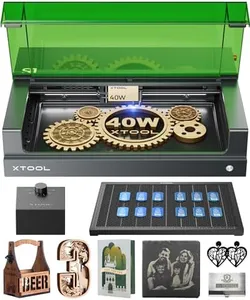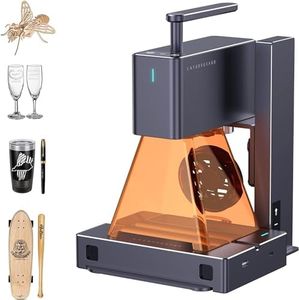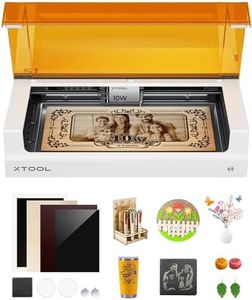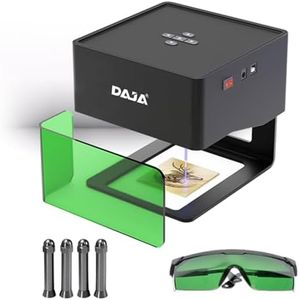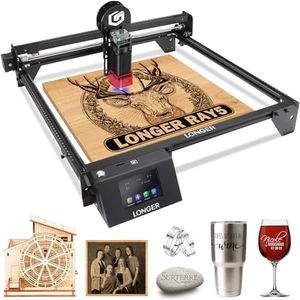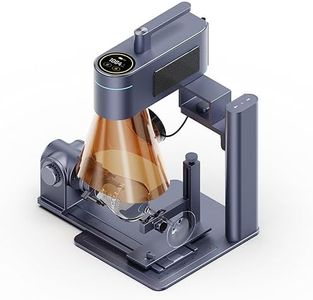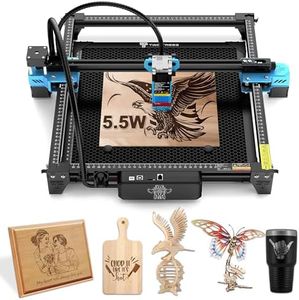We Use CookiesWe use cookies to enhance the security, performance,
functionality and for analytical and promotional activities. By continuing to browse this site you
are agreeing to our privacy policy
10 Best Budget Laser Engraver
From leading brands and best sellers available on the web.Buying Guide for the Best Budget Laser Engraver
Choosing a laser engraver can be exciting, especially if you’re eager to start personalizing items or creating unique crafts. The key to buying the right one for you is to think about what you'll use it for most—like engraving small gifts, customizing tools, or starting a small business—and to match those uses with a machine's actual capabilities. Pay close attention to the type of materials you want to engrave and how much space you have to work with. Understanding a few essential specifications will help you find a model that fits your needs without overcomplicating things or including features you’ll never use.Laser Power (Wattage)Laser power is the strength of the laser, usually measured in watts, and it determines how effectively and quickly the engraver can cut or mark different materials. Lower wattage lasers (around 3-5W) are best for engraving softer materials like wood, leather, or paper, but generally can't cut through thicker materials or engrave certain metals. Mid-range wattages (10-20W) allow for deeper engraving and cutting, and offer more versatility for a hobbyist or small business. Higher wattage lasers (30W or more) can handle a wider range of materials, including some metals and thicker surfaces, but may be unnecessary for simple crafts. Think about what you plan to engrave most often; lighter projects mean lower wattage is fine, while heavier or professional projects may call for more power.
Work Area (Engraving Bed Size)The work area, or bed size, tells you how big of an object or design you can work with at once. Small machines might have a work area of just a few inches square, making them suitable for jewelry, keychains, or small crafts. Medium-sized bed areas allow for engraving plaques, phone cases, or notebook covers, while larger beds can handle signs and bigger projects. Select a size that matches the majority of your intended work—if you’re only doing small items, a large bed isn’t necessary, but if you have ambitions to create bigger works, choose a spacious model.
Supported MaterialsSome laser engravers can only work with certain materials, like wood, acrylic, or leather, while others are capable of handling metals, glass, stone, or even fabric. Look at the list of supported materials for any engraver and compare it to the projects you hope to do. If you specifically want to engrave metal, make sure the engraver is rated for it; otherwise, most budget models are primarily for organic materials. Matching your material needs to the engraver’s capabilities ensures you won’t be disappointed later.
Precision (Spot Size and Resolution)Precision refers to how finely the laser can engrave or cut details, usually mentioned as a spot size or as resolution in dots per inch (DPI). A smaller spot size or higher DPI means finer, more detailed engravings, which is great for intricate designs or delicate artwork. For simple patterns or large text, high precision isn’t as critical. If your work involves a lot of small fonts or tiny decorations, look for a machine known for its accuracy.
Ease of Use (Software Compatibility and Controls)The engraver is only as easy to use as the software and controls that run it. Some require specialized programs that can be difficult for beginners, while others are compatible with popular design software or include simple, touchscreen interfaces. If you’re new to laser engraving, seek out a machine with straightforward controls and software that fits your current experience in digital design. The easier the interface, the faster you can get started.
Safety FeaturesLaser engravers can be dangerous if not handled properly, which is why safety features are important. Common features include emergency stop buttons, protective covers, and systems that shut down the laser if the device is moved unexpectedly. Especially in budget models, it’s good to have basic protections in place, particularly if the engraver will be used in a home, school, or around children. Your comfort level and environment should guide which safety features matter most.
